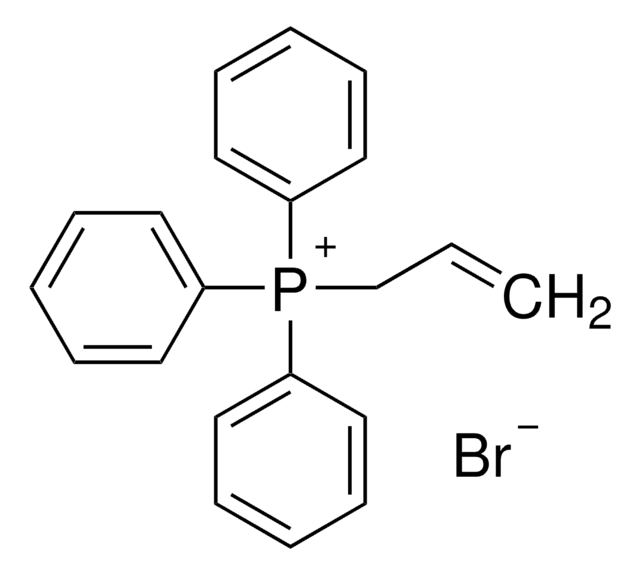B32807
Benzyltriphenylphosphoniumchlorid
99%
Synonym(e):
BTPPC, NSC 116712, Triphenyl(phenylmethyl)phosphonium chloride
About This Item
Empfohlene Produkte
Assay
99%
Form
powder
Eignung der Reaktion
reaction type: C-C Bond Formation
mp (Schmelzpunkt)
≥300 °C (lit.)
SMILES String
[Cl-].C(c1ccccc1)[P+](c2ccccc2)(c3ccccc3)c4ccccc4
InChI
1S/C25H22P.ClH/c1-5-13-22(14-6-1)21-26(23-15-7-2-8-16-23,24-17-9-3-10-18-24)25-19-11-4-12-20-25;/h1-20H,21H2;1H/q+1;/p-1
InChIKey
USFRYJRPHFMVBZ-UHFFFAOYSA-M
Suchen Sie nach ähnlichen Produkten? Aufrufen Leitfaden zum Produktvergleich
Verwandte Kategorien
Anwendung
- Platinum chloro-tetrazole complexes via azidation.
- Trans-stilbenes and cinnamates via Wittig olefination.
- Achiral N-hydroxyformamide inhibitors of ADAM-TS4 and ADAM-TS5 for osteoarthritis treatment.
- Pentiptycenes for use as light-driven molecular brakes.
- Archipelago structures for formation of petroleum asphaltenes.
It is also used as a crosslinking agent for tube-like natural halloysite / fluorelastomer nanocomposites.
Reactant for synthesis of:
- Platinum chloro tetrazole complexes via azidation
- Trans-stilbenes and cinnamates via Wittig olefination
- Achiral N-hydroxyformamide inhibitors of ADAM-TS4 and ADAM-TS5 for osteoarthritis treatment
- Pentiptycenes for use as light-driven molecular brakes
Reactant for formation of archipelago structures for formation of petroleum asphaltenes
Signalwort
Danger
Gefahreneinstufungen
Acute Tox. 2 Inhalation - Acute Tox. 2 Oral - Aquatic Acute 1 - Aquatic Chronic 1 - Eye Dam. 1 - STOT RE 1 - STOT SE 3
Zielorgane
Lungs,nasal cavity, Respiratory system
Lagerklassenschlüssel
6.1A - Combustible acute toxic Cat. 1 and 2 / very toxic hazardous materials
WGK
WGK 3
Flammpunkt (°F)
572.0 °F - closed cup
Flammpunkt (°C)
300 °C - closed cup
Persönliche Schutzausrüstung
Eyeshields, Faceshields, Gloves, type P2 (EN 143) respirator cartridges
Analysenzertifikate (COA)
Suchen Sie nach Analysenzertifikate (COA), indem Sie die Lot-/Chargennummer des Produkts eingeben. Lot- und Chargennummern sind auf dem Produktetikett hinter den Wörtern ‘Lot’ oder ‘Batch’ (Lot oder Charge) zu finden.
Besitzen Sie dieses Produkt bereits?
In der Dokumentenbibliothek finden Sie die Dokumentation zu den Produkten, die Sie kürzlich erworben haben.
Kunden haben sich ebenfalls angesehen
Unser Team von Wissenschaftlern verfügt über Erfahrung in allen Forschungsbereichen einschließlich Life Science, Materialwissenschaften, chemischer Synthese, Chromatographie, Analytik und vielen mehr..
Setzen Sie sich mit dem technischen Dienst in Verbindung.










